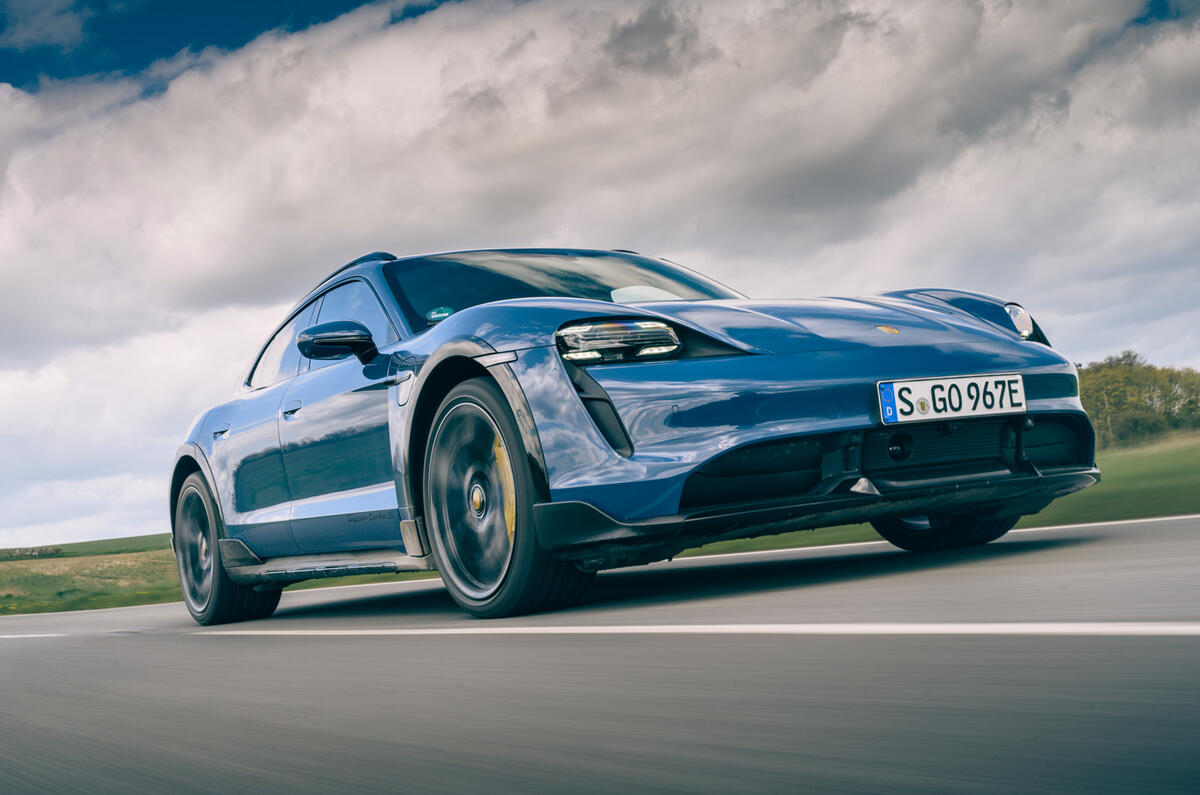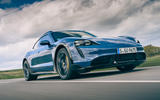What is it?
Every summer, students graduating from the prestigious Vehicle Design masters course at the Royal College of Art put on a show. Many of the scale models on display are spectacular, as you would expect given that they’re dreamed up in the brains of one-day chief designers for the world’s greatest car makers.
However, the ideas are often equally unrealistic: deliberate flights of fancy belonging far into the future. The cars look wild and purport to do everything you could imagine, but they could never actually exist.
You can see where we’re headed here: the new high-riding, shooting brake version of the Porsche Taycan, the new Porsche Taycan Cross Turismo, feels a lot like one of those end-of-year concepts at the RCA. Only it’s on sale in 2021, rather than 2121, and, in its most basic 4 form, costs little more than BMW’s new M3 Competition, at just under £80,000.
For that price, you receive 469bhp in an elegantly low-slung (if reptilian) shooting brake body that has Ferrari-grade kerbside ‘wow’ factor but is also fitted with roof rails and mounts at the rear for a bike rack. It’s all outside the ordinary. Yet that’s not all, because the comparatively sensible 4 isn’t the car we have here.
Our first taste of the Cross Turismo in non-prototype guise instead comes in the form of the steaming-hot £140,000 Turbo S, which sits at the very top of Porsche’s now eight-strong line-up of Taycan derivatives and straight away seems an even more extraordinary device.
The Turbo S in particular is an automotive platypus: impossible to categorise. More than 750bhp and an extremely low centre of gravity are pure supercar, but three-chamber air suspension, space for four (or five, with the optional rear-bench configuration) and an opulent cabin suggest plush-riding family GT.
Overlaid on this are five ride- height settings, beefy wheel-arch claddings and a Gravel mode, all of which hint at some level of rough-road ability, and, along with the improved head room, are where the Cross Turismo delineates from the regular Taycan saloon.
The long shooting brake silhouette then allows for a generous 1171 litres of boot space when the rear seats are folded flat; and even with the backrests up, you still get more than 80% the capacity you do in the BMW 3 Series Touring. Real utility, in other words, even if the aperture itself is high-lipped and slightly narrow, on account of the Cross Turismo’s phenomenally broad hips, which cover 305/30-section Pirellis and optional open-worked 21in wheels.
Finally, there’s the fact this thing is electric. And that’s the most startling element of the package, because before 2019, no road-going car had left Zuffenhausen without pistons. So, what exactly is the Cross Turismo Turbo S? Beyond an engineering flex of truly Schwarzeneggerian proportions, I’m still not sure.
What it isn’t is light. Its 2320kg kerb weight exceeds that of even the longer, taller and twin-turbocharged V8-engined Panamera Turbo S Sport Turismo by 185kg. That’s a result of the 93.4kWh battery, which yields a claimed 260 miles or 308 miles in city driving. As for charging, the 800V electrical system (400V is more typical in the industry) means the pack can theoretically replenish from 5% to 80% capacity in 20 minutes.













































Join the debate
Add your comment
We've got the awesome Taycan, and now this crossover version, and the Macan EV will launch quite soon. What's missing is a two door sports car EV, with 911 style and Taycan performance. The Tesla Roadster is coming, why not the Porsche EV Coupe?
Niche cars attract different minds than mine. Not a fan of Elon but my neighbor's Model X has huge capacity and performance - the way its effortless instant torque allows it to safely join traffic in rush hour is amazing. In the ICE world, an E63 wagon has appeal as it loses no practicality but adds huge performance. But this Taycan Turismo cargo space is miniscule even with the seats folded, and with 4 adults onboard (in the cramped interior) there there would be 20% less luggage capacity than in a non-Turismo Panamera.